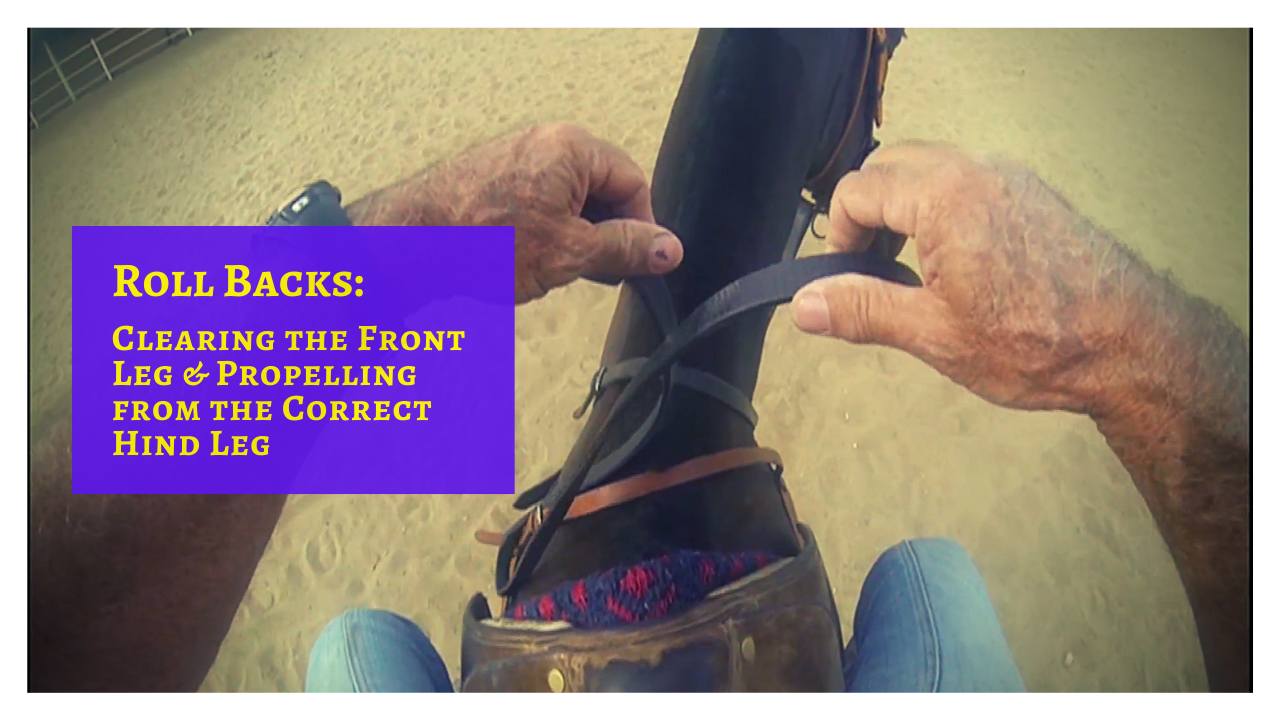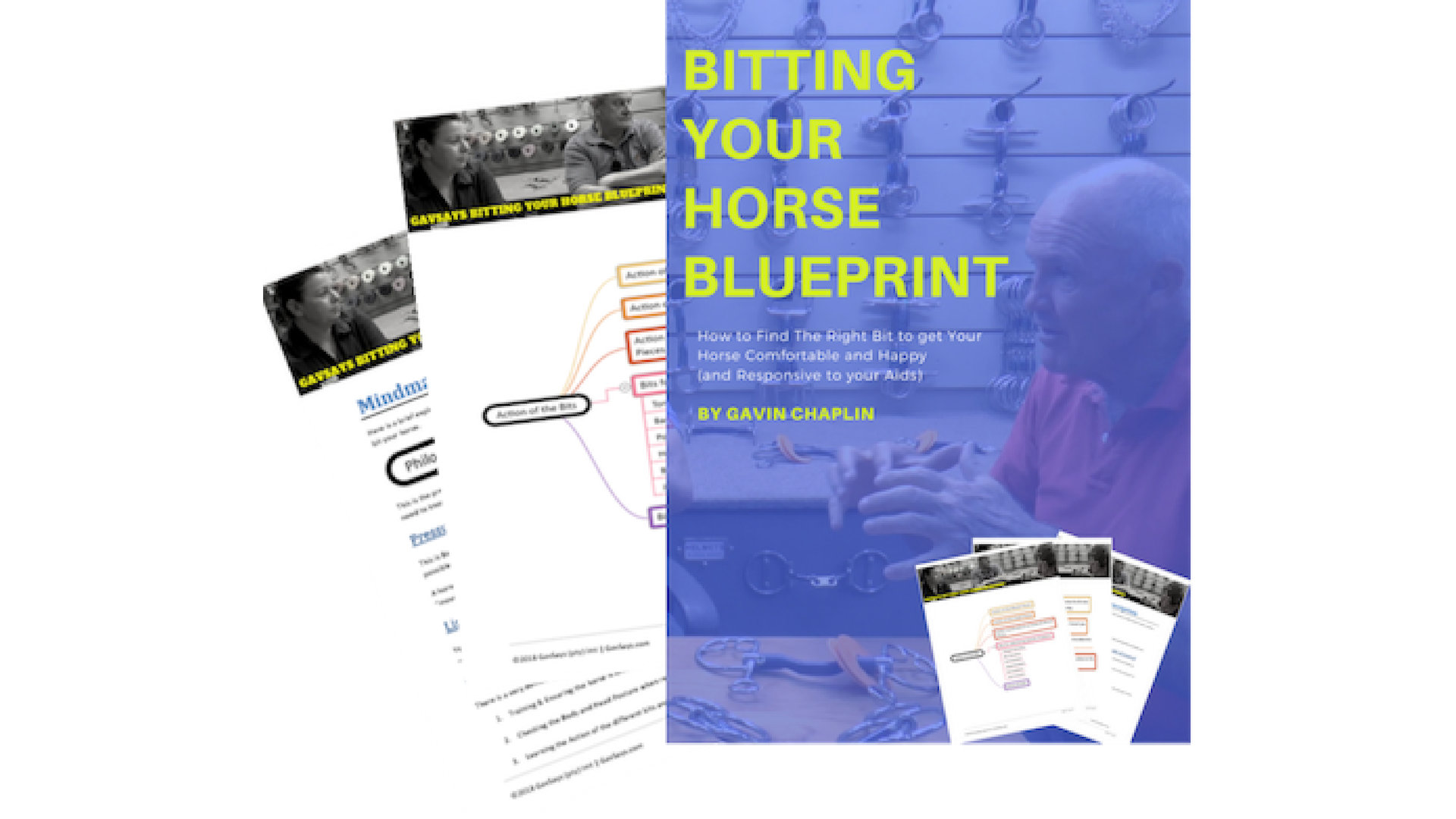Polished Roll Backs:
Clearing the Front Leg & Propelling from the Correct Hind Leg
Do you want your horses to be able to do polished, smooth and quick roll backs?...
Well - If you want to successfully teach your horse how to do polished and effective "Roll Backs" - it is imperative to first teach them...
1. How to step correctly with the front legs, so that they do not step on themselves.
2. And how to propel themselves with the correct hind leg.
This video shows you the first steps in that process.
Polished Roll Backs
Transcript:
With this mare, she's a multiple winner on the race course, and she's a really willing girl. But, obviously, on the race course, they don't care too much where they are putting the horses heads. And she has this habit of carrying her head completely on the left-hand side. And that makes her very slow to turn back to the right-hand side.
So, what I'm trying to do, a lot with her to start with, is again, with the side passing, to use that inside leg and to get her like this, just to drop her head onto the inside, you can see it slightly inside before I ask for the turn and that is getting her to turn in a much flatter way. What's been happening is she's been ridden here without people taking enough notice of that. And what's happening is she's coming up while she's turning.
And she's also, because she's been forced on the race course. She has the tendency to want to go up in front, which is a really problematic thing for a horse. So, to start with what I'm going to do is just to get this horse to learn, to stand, put her head on the inside without moving, you can see the resistance there.
So, if she will just learn to stand first and put her head softly there, I take all my aids off her and let her just stand and understand that she can just stand there, without having to back up, without having to do anything else. You can see very light pressure on the reins and I'm using fingers here to help her on the inside, not a pull with my arm.
Once I've got her in the correct body position, then I can use an outside leg and the outside rein to help her turn flat to the inside like that. Now, as I said in the introduction, what I'm trying to help this horse do is to learn to step first with this inside leg, because that's what she hasn't been doing. So, once I've got a flexed onto the inside like this, she's perfect now.
With the outside leg, there's the leg step, step and then move out. So, that's the lesson that you have to teach this horse before you start to go to more advanced lessons. So, step, step, move out. She's starting to really, after a few days, get this lesson.
So here, just back her a step, step, and go. And I back her, just a fraction to get her weight onto her back legs. Now you will see also on the back legs when I'm doing that, as she goes. As I back her and I go, there's the wrong leg moving first, do you see? And that would step on herself.
So, here this step step, and she's pushing off that back leg and carrying herself on the inside, just as a human being would be doing, if they would be walking to the right, of stepping off the left-hand back leg and balancing yourself and transferring your weight to the right, not pushing off of the inside. So, once she's got that feeling uncontained, because the barrier here is a problem for this horse. What I've got to be really careful of is that I never jammed this horse into the poles.
If I get too close here, before I asked the turn. The poles themselves, the barrier, is going to make her come up and over. Okay. Especially when I come in at a trot, but if I will give her just a little bit of room there, you can see me just bending her correctly. Here we come in. If I stop at this sort of distance and now get that. She's very much more inclined to move forward and propel with the back legs rather than hop for the front legs.
To the left-hand side, here we are. Come in here, check half a step back. There's a beautiful inside step to the left-hand side, she finds that so easy. She will always move the correct leg first. Here, you've got to bend her first, now step, step, and she's starting to get these lessons.
Another really important thing in the use of the actual area of the arena is when you ask in these lessons to start with, the corner is an ideal place to work because when they step out, you still have a barrier, but it's not in the horses face. Okay?
So, if I'm here, once I check up here and get the horses head, now you can see she can move into the corner and on a round where if I go further away from the corner, what's going to happen here, is that once I stop, just get this horse's head on the inside.
Check here. When I make this turn here, there's still a barrier in front of me and she gets very much more jammed in there. You will see if I do that exact same maneuver more into the corner, how much easier it is for the horse you see here now, when I check and go forwards, now she's got space to move in, but there's still a barrier helping her to make the turn.
So, I'm much lighter on my hands. Once she gets those ideas, then I can start to use the length of the arena and start to come in down here where again, 45 degrees to the poles is a really good approach here because when I check here, there, and she will turn very easily with space here to be able to move through, don't get to where you are parallel to the rails. It's too much for a young horse. You can get there later with a more mature horse, that's that's better schooled.
So, if I'm 90 degrees to the rails here, it's a much bigger ask, and you can see how the horse unbalances when you do that. Where, if I'm going to give her the chance to learn, I'm going to be at 45 degrees, check here, and you can see how much easier that turn is for her. So, once I've got all that right at a walk, then I'll start at a trot. And once she gets into the trot, I will then go to a canter.
Just while I'm talking about this, a really important thing, is how you holding your reins.
What I do is I bridge the left-hand rein through these two fingers, like that. And I'm using this finger and this finger to hold those reins. I sit this rein at the length I want to work. This rein here is held between thumb and forefinger. And you will see when I want to turn right. I can use that to shorten up and to use a finger here to help.
We're not going to turn left. I just let the rein slide, I've anchored the left rein, until the left rein is shorter. This is just a touch long. There we go. Now you see the correct rein is short and her head is in the correct position. So, if I'm going to turn to the right, now, I would use right aid, shorten these reins, use the finger here. You can see her resist a little.
Now when she's put her head in the correct place, the reins are soft. I will now ask you to turn with the outside aid. And you can see here that the neck rein, the outside rein, is what's making her turn again here, open my hand, let this rein slide, until this left aid on now, until she drops her head.
When she's in a good position, rein's a soft outside aid outside rein asking you to turn. So, her body position is crucial here to getting her to do the right things. Here's this rein anchored. I'm going to get into a trot now and start just very slowly getting this horse to understand what I'm asking and there's this with this finger able to help me to the right-hand side.
So, let's go to a trot and you can see these reins of beautifully loose. This horse has really responded. Now I'm going to give her just to get that head on the inside. I'm using an inside aid and a slight inside rein and this rein, the right rein is longer. And now that right rein, as I take my hand across will be what makes her turn.
When I'm going to turn now to the right-hand side, you will see as I come out of this turn, don't keep your turn go straight first. Now I'm going straight. Okay. And I shortened up this rein, get her head correct first, and now ask for the turn. Don't ask for the turn. And there, you can see that finger helping on the inside just to get the head where I want it.
But don't ask for that turn until the head is in the correct position. We're going to now turn left. So, I'll let this rein slide. Now my left rein is shorter inside aid, get the horses head where I want it. And then ask for the turn. And you can see a very smooth, easy turn for the horse. Now we turning left.
So, my inside rein is slightly shorter. My hand is to the left and this rein is what's making her turn. Okay. So, straight on here, get the head on the right side, bump with my right leg. And there is, you can see her leave that head behind. And that's the side she's battling too. So, I'm just going to help with my right hand pushing forward this one.
So I've got a little tension here that I can give straight away with, there. Okay. Just to get a bent correctly, before I ask her to turn, and maybe with this hand slightly wider, just to keep that head on the inside. That's the lesson this horse has to learn before she does anything else. Again, I'm shortening the right-hand rein, make her checkup, half a step back. Step, step, and push out.
Now eventually what one's going to do is ask her to step out into a canter, okay. And strike off immediately into a canter. But before you start to do that, make sure she can first do it at a trot. Come on, come on. And this was really couldn't lead on this lead to start with.
So, this is a big, big improvement on her. And you can see me here helping a lot with my right hand to get that head into the correct position, so that when she's going along, she's got her head in the right place. When you pull on this right rein, she wants to check. She thinks that you're stopping her and she's got to learn just to put her head on the inside and go with my reins are soft and keep her head there.
So, now you start to see the blending of the lessons of why it's so important to teach horses, to put their head on the inside and leave it there. Now she's starting to get the feeling and she's moving forward very nicely. So, once she's got that and you've balanced her, now you can see there, check, check and step out into a canter on that side.
And also another thing just to remember is don't always do these stops in the same place you can feel as I'm coming around with was wanting to stop because she's used to being stopped there and I'm just going to do it in different places. So she doesn't start to stop because she thinks that that's where she should stop. So, right-hand rein will come back, bend her.
No, no, no, no. I don't want that. I don't want that. Come back. There we go. Then here, that's what I'm looking for, strikes straight off into a canter now. And they're actually starting to put that head much more naturally to the right-hand side for me, just do one last stop here. Half a step back up, forward.
And there she goes straight into a canter using your right hand to help you. There she goes, beautiful. Beautiful. Give her time to make the move. Don't force her to start with, cause that's what makes these horses go up. Stand, stand, stand. Just get the patience as well. Stand. You don't have to do anything. Stand, stand.
That's what I want. Now she's in a snaffle okay. Because any Gag or Pelham tends to accentuate the up. Where the snaffle might....stand up, got to teach this patience as well that this horse learns to stand. Okay. She's never done that on the race course and learn to stand. So, this is as important, a part of the lesson as any of the other things you are teaching. That they learn when you're doing nothing, that they will just stand and do nothing. Okay.
But I'm using a snaffle on her and it's got a slight twist in it to make it a stronger snaffle, because she doesn't have a wonderful mouth, but she's learning to stop very nicely on the snaffle. But what it's not doing is, like a gag would do, pick her up. A Pelham also tends to pick them up.
So, I'm having to work with a whole lot of different problems here, and the solutions are slow and not easy to find. I played around with different bits. This is the one that she's easiest on and will stay on the ground with.




Comments
Got questions, comments or feedback! Then have your say in the box below...